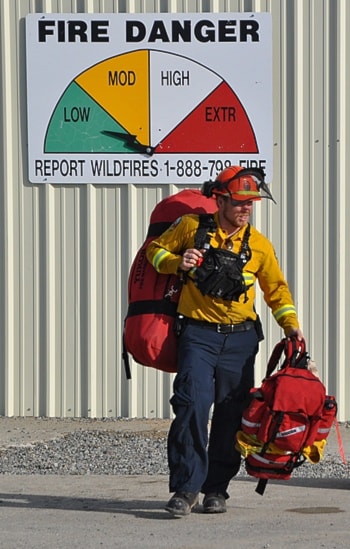The current wildfire season is shaping up to be a historic one.
Sporadic wet weather and lower temperatures have kept blazes in the territory at bay throughout the summer.
Wildland Fire Management has only recorded 28 fires to date, which have burned 740 hectares of land.
That’s a far cry from the 144 fires that burned just over 200,000 hectares of land last year.
Fire information officer George Maratos said there have never been fewer wildfires in a year.
“We’ve been tracking them for approximately 50 years,” he said.
“It’s been a very unusual year.”
The five-year average is 99 fires and 125,000 hectares burned, he added.
Maratos said there haven’t been any significant fires to battle this season, which has made Yukon firefighters more available to help in other jurisdictions.
Twenty-five of them were dispatched to the N.W.T., where more than 340 fires have burned roughly 2.8 million hectares of land this summer, while 17 are lending assistance in B.C.
Other personnel, such as division supervisors and agency representatives, are also helping in those jurisdictions.
Premier Darrell Pasloski announced this morning that any N.W.T. residents displaced by fires in that territory would be welcome here in the Yukon.
“It has been a challenging year of forest fires for the Northwest Territories and we understand that their resources are stretched,” Pasloski said in a news release. “With that in mind, I contacted Premier (Bob) McLeod to let him know that our doors are open to our neighbours in the N.W.T.”
The Emergency Measures Organization would co-ordinate the effort, should the N.W.T. take up Yukon’s offer for help.
Maratos said weather conditions have created the “perfect recipe” for a slow fire season.
Even Dawson and Carmacks, which typically get less rain, have been getting showers this summer.
“Typically we’ll get air tanker requests in late May, early June,” Maratos said.
“But we didn’t see any until mid-July this year.”
Most fires in the territory are started by lightning strikes but a small percentage are human-caused.
“Hats off to Yukoners, who have done a good job of burning responsibility and making sure their fires are out,” he said.
At this time in 2013, Yukon firefighters were working hard to contain fires in Dawson, Mayo, Carmacks, Teslin and Whitehorse.
The worst wildfire season on record in the territory was in 2004, when 261 fires burned 1.74 million hectares of land.
As of Aug. 5, the fire danger rating for Yukon communities was low to moderate.
Carmacks has seen the most fires this year with eight.
Campfires are permitted outside of Whitehorse city limits and the public is reminded that burning permits are mandatory for any burning of brush, grass or debris.
Contact Myles Dolphin at myles@yukon-news.com
